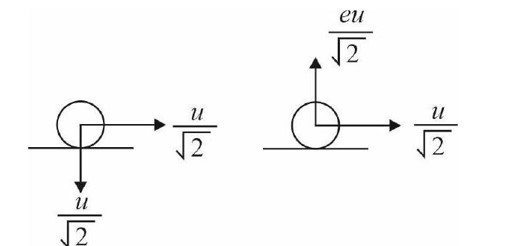A smooth spherical ball strikes a smooth horizontal floor at an angle
. The coefficient of restitution between the ball and the floor is
. The fraction of its kinetic energy lost in collision is: (there is no rotational kinetic energy before or after collision)
A smooth spherical ball strikes a smooth horizontal floor at an angle
. The coefficient of restitution between the ball and the floor is
. The fraction of its kinetic energy lost in collision is: (there is no rotational kinetic energy before or after collision)
Option 1 -
Option 2 -
Option 3 -
Option 4 -
-
1 Answer
-
Correct Option - 2
Detailed Solution:Vertical component of velocity just after collision
Fraction
Similar Questions for you
Using Conservation of Mechanical Energy at point-A and at point-B, we can write
K_B = U_A - U_B [Since K_A = 0]
⇒ (1/2)mv_B² = mg (h_A - h_B)
⇒ v_B = √ (2 × 10 × (10 - 5) = 10m/s
For elastic collision
No. Since kinetic energy is a scalar quantity, it only depends on speed of the body and not the direction. So if the direction of the body is changed but the speed remains unchanged, there won't be any effect on the kinetic energy. However, if changing the direction also changes the speed of the body, then kinetic energy of the body will also change.
If you look closely at the formula of kinetic energy (1/2*m*v^2), the velocity is squared which automatically gives a positive integer. And mass of the body can never be a negative value, which leads to the result being a positive integer.
The 1/2 is a result of mathematical calculation, which occurs when we integrate? vdv in the formula of work done according to Newton's second law of motion. Without this, the final result will turn out to be twice of the actual value.
Taking an Exam? Selecting a College?
Get authentic answers from experts, students and alumni that you won't find anywhere else
Sign Up on ShikshaOn Shiksha, get access to
- 65k Colleges
- 1.2k Exams
- 678k Reviews
- 1800k Answers

